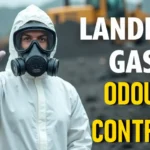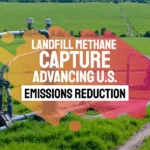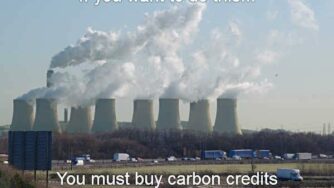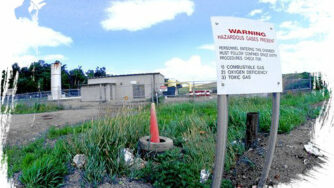Greenhouse Gas Generation – Landfilling and Incineration Compared
So, you want to know which is better for the planet's greenhouse gas emissions – Landfills or Incineration?
When waste is incinerated, two greenhouse gases are produced, carbon dioxide and nitrous oxide. The IPCC has produced detailed guidance on what counts as a greenhouse gas and what does not.
Applying these rules to incinerator emissions, only the carbon dioxide produced from the combustion of fossil (non-biogenic) carbon (eg plastic) counts as a greenhouse gas. That from biogenic material (paper, wood etc) does not count because its carbon is part of the natural carbon cycle. If the incinerator utilises the combustion heat then the energy produced substitutes for energy generated from fossil fuel. The net greenhouse gas emissions from the incinerator are calculated by subtracting the emissions avoided from the gross emissions.
When similar waste is landfilled, only one greenhouse gas is produced, methane. All of the methane is counted as a greenhouse gas because landfill methane is not part of the carbon cycle. The carbon dioxide in landfill gas is produced by anaerobic digestion from biogenic carbon and so it is counted as a greenhouse gas. If the methane is flared it is converted to carbon dioxide which again does not count as a greenhouse gas because it is biogenic in origin.
Furthermore, if the methane is utilised as an energy source the energy produced substitutes for fossil fuel-derived energy and the avoided emissions can therefore be subtracted from the gross landfill emissions. Landfilling has one other surprise in store. Some of the organic matter degrades so slowly that it is classed as stored or sequestered. When considering whether landfilling or incineration, is better this can also be counted as avoided emission and deducted from the gross emissions.
All of this sounds like comparing apples with oranges. How can the real greenhouse gas impacts of different gases be compared and how can the avoided emissions be quantified?
And then, if we are to compare the merits of alternative waste management schemes, landfills, or incineration, how are we to take into account the greenhouse gas emissions from waste collection, haulage etc?
In fact, IPCC recommends a fairly straightforward methodology whereby different greenhouse gases can be compared by using carbon dioxide as a datum for comparison. By definition 1 kilogram of carbon dioxide has a Global Warming Potential (GWP) of 1. Methane has a GWP of 21 so 1 kg of methane has the same heat-trapping potential as 21 kg of carbon dioxide.
To enable simple direct comparisons to be made for the landfills, or incineration, comparison between different gases and different scenarios, it is helpful to convert emissions to their Total Carbon Equivalents. Carbon dioxide is 12/44 (0.27) carbon. The TCE of any greenhouse gas can be calculated simply by multiplying its GWP by 0.27. So 1 tonne of carbon dioxide is equal to 0.27 tonnes Total Carbon Equivalent (TCE) and 1 tonne of methane is equivalent to 21 x 0.75 or 15.8 TCE.
If we assume that after decomposition, in the long term, all the carbon in the waste sent to landfill will be converted to carbon gas, as it will, we assume do so in the short term, during incineration, the relative carbon tonnages are equal.
However, the impact of even a small methane emission, (even if most methane gas is flared and becomes carbon dioxide), is so much greater than the TCE for the equivalent carbon dioxide produced, that the incineration option has to be considered.
In the “Landfills or Incineration” comparison the results of comparing incineration of a unit tonnage of typical household waste with landfilling the same tonnage – assuming collection, haulage and the other externalities are broadly similar in both cases – are surprising because they depart significantly from the “landfill bad – incinerator good” dogma with which we have become so familiar. The fact is that we should be quite clear that if incineration is to be rejected as a mainstream residual waste treatment option in the UK, the reasons for doing so will clearly lie elsewhere.
So, which is best “Landfills or Incineration”? In a recent US study, the landfill with methane extraction and electricity generation comes out slightly better than the incinerator, but the differences are so small that the externalities such as emissions from haulage can make all the difference.
Landfills or Incineration? The Conclusion
Global warming (Climate Change) may or may not be a reality.
By applying the IPCC's protocol, it becomes clear that there is not much to choose between the net greenhouse gas emissions of an incinerator with energy recovery and a landfill with landfill gas utilisation. So, when considering whether to prefer landfills or incineration, on the grounds of the greenhouse effect from emissions there is no strong argument either way.
The reasons for public rejection of incineration may be many, but should not be based on global warming issues in this instance.
Further Reading on this Topic:
Best Practices in Odour Control Using Landfill Gas Extraction Systems
Landfill gas extraction systems effectively control odour by capturing and treating gases from decomposing waste. Proper system design, strategic well placement, and regular maintenance are crucial for minimizing fugitive emissions and odour complaints, with reductions of up to 85% achievable when these best practices are followed…
Methane Emissions from Landfills: Problems and Solutions
Methane emissions from landfills significantly contribute to climate change due to their potent greenhouse effect. Capturing and utilizing landfill gas as energy, reducing organic waste, and enhancing recycling are vital solutions. Community engagement and effective policy regulations are key to mitigating these emissions and tackling global warming effectively…
Landfill Gas Pin Wells: A Low-Cost, High-Impact LFG Extraction Option
Discover the advantages of landfill gas pin wells, a cost-effective solution for efficient LFG extraction. Easier installation, lower costs, and increased gas capture make them ideal for sustainability. Learn how pin wells transform waste into energy, reducing emissions and supporting renewable projects across waste management facilities…
Landfill Gas Capture: Advancing U.S. Emissions Reduction Through Technology and Policy
Harnessing Landfill Gas: Progress and Challenges in U.S. Emissions Reduction Efforts The management of landfill-derived gas represents one of the most significant opportunities in America's climate strategy. As a potent greenhouse gas with 28-36 times the warming potential of carbon dioxide over a 100-year period, methane demands urgent attention from policymakers, waste management professionals, and […]








Hello, you write magnificent on landfill gas, but this post misses the point. The question is which is best landfills vs biogas production. Incineration actively inhibits recycling and is not the partner technology to use.
Daily soil cover at the landfill to keep bird and vermin away… incineration missing the energy recovery technology, pollution abatements such as Electrostatic Precipitators and catalytic converters….bottom ash usually goes to the hazardous waste facility, fly ash can go to a MSW landfill…steam can also be used in co-generation or drive a turbine for electricity production.